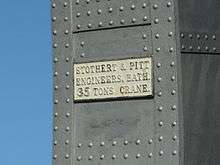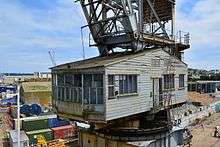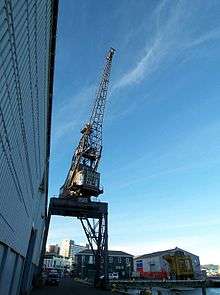Stothert & Pitt

Stothert & Pitt were a British engineering company founded in 1785 in Bath, England. They were the builders of a variety of engineering products ranging from Dock cranes to construction plant and household cast iron items. They went out of business in 1989. The name and intellectual property became part of Clarke Chapman.
History
The company was founded by George Stothert in 1785[1] having taken over Thomas Harris's ironmonger's business. He was an agent for Abraham Darby I's Coalbrookdale Iron Company, selling all types of domestic ironmongery. By 1815 they set up their own foundry as Abraham Darby had opened his own warehouse in Bristol. The company was now managed by his son, also George. In 1851 they exhibited a hand crane at the Great Exhibition.
Building the 35 ton Fairbairn steam crane for Bristol docks in 1876, to an improved design by William Fairbairn. The boiler maker's plate reads "Marshall Sons & Co. Ltd., Engineers, Gainsboro, England, No.92766".
In 1837, Henry Stothert, brother of the younger George, began manufacturing steam locomotives in Bristol, first as Henry Stothert & Co., later and better known as Avonside.
Robert Pitt joined the company in 1844 and the firm became Stothert and Pitt. The firm became a limited company early in the 20th century.[1]
20th century
Building rail cranes for export to the colonies.
Electric dock cranes

Stothert and Pitt supplied their earliest electric powered crane to Southampton Dock Authority in 1892. Electric power provided several advantages: powerful motors could be placed in each crane and powered centrally, without requiring a separate prime mover (i.e. steam engine and boiler) in each crane. The crane mechanisms were also lighter, allowing them to be placed on raised carriages that could then straddle a railway freight line- the portal crane. Rather than requiring a bare strip of unused quayside between the railway line and the harbour wall to leave space for cranes, the railway could now be brought right to the dock edge. Cranes were also available immediately, without waiting for boilers to raise steam. Most importantly though (and an advantage over centrally powered hydraulic cranes), electric cranes were now mobile along the dock edge on their own rail lines. Rather than ships queueing for a single berth space alongside a fixed crane, cranes could be brought to each ship's hold hatches as needed. This made a single crane far more efficient, in terms of cargo handled per day. Soon such mobile electric cranes were near universal.
Five examples of electric cranes provided in 1951 have been preserved by Bristol Museum Service at Princes Wharf.

Level-luffing cranes

In 1912, Stothert & Pitt's design team, led by Claude Topliss, developed an improved design of level luffing gear, which greatly improved the speed and efficiency of cargo handling cranes fitted with it. .[2] This used an arrangement of compensating hoist cables to automatically keep the hook, and load, level as the jib was luffed up and down.
Bulk handling cranes
As cranes became more common in docks, and as ships became bigger, they also became more specialised. In 1927, Stothert & Pitt produced the first bulk-handling crane.[3] Rather than a simple hook that could handle a range of slung loads, this was a crane designed around the use of an integral grab. Working the grab requires extra cable or cables from the crane jib, so these are a whole specialised design. The first was to unload coal at a power station in London.
Another innovation was the kangaroo crane. Rather than slewing (rotating) the crane to reach the delivery hopper on-shore, a kangaroo crane has its own in-built hopper beneath the jib, that slews with it. Dumping the grab contents into the hopper now only requires the quicker luffing movement, without needing to slew.
Wartime
In July 1915 the company took over the construction of the Pedrail Landship, an attempt to create an armoured fighting vehicle for use on the Western Front. The machine, designed by Colonel R.E.B. Crompton, a consultant to the Landships Committee, ran on a pair of pedrail tracks in tandem. It was intended to mount an armoured body on the chassis so that a party of troops could be carried across no-man's-land. After the Landships Committee decided against the machine, the War Office transferred construction to S&P, with a view to completing it as a mobile flame-thrower. The finished chassis was handed over to the Trench Warfare Department in August, but no further development took place.
During World War II the company built tanks and miniature submarines for the War Office, as well as armaments.
Tank design
The Challenger tank was a development of the Cromwell tank chassis, so as to take the more powerful 17 Pounder gun. Stothert & Pitt not only built this tank, they also designed the modifications.[4] Lengthening the chassis from 5 roadwheels to 6 was no difficulty for such an engineering firm, but designing armoured fighting vehicles was new to them and their results weren't entirely successful. The new turret for Challenger carried the gun and its higher recoil well enough, but only by being nearly twice the height of other turrets for this chassis - making the overall tank a much easier target. The A30 (Avenger) tank destroyer was a similar development of a 17pdr gun on the same lengthened chassis, but had an open-topped turret 2 feet lower than the Challenger. During development of Challenger, the prototype turret was first mounted on the even more leviathan TOG 2.[4]
Post-war
By 1974 they had built 30,000 single drum pedestrian rollers.
Current operations
The firm was sold to Robert Maxwell's Hollis Group in 1986. Following the collapse of Maxwell's empire a management buy out was undertaken in 1988. But this failed and the company closed in 1989, resulting in all the works shutting down. The Stothert & Pitt name was sold to Langley Holdings, which now belongs to the NEI group owners of Clarke Chapman, and is operated for Dock crane consultancy. Despite ceasing all manufacturing operations, the company existing for consultancy, reference and repairs from their new headquarters at the Bradman Lake offices in Bristol.
Stothert & Pitt moved from Bath to Bristol in Summer 2008 and now occupy three office annexes in the Bradman Lake British headquarters on Yelverton Road in Brislington.
Model range
Construction machinery
- Pedestrian rollers
- Vibroll 28W Roller
- Concrete mixers
- "Victoria" mobile mixers
- Lorry-mounted concrete mixers
- Concrete batching plants
- "Super 64" concrete mixer - used for runway construction
- No.16 Tarmacadam plant for the war office
- Cranes
- Goliath type yard cranes
- "Titan", a 50 ton block-setting cranes built in 1899 for building breakwaters at South Shields.[5]
Other products
- Dock cranes
- Container loaders from the 1970 onward
- Goliath cranes for dock building
- Electric dock cranes (some still preserved Bristol docks & also 12 grade 2 listed dock cranes in Royal Victoria Dock in London's east end E16)
- DD2 Dock cranes, 5ton @ 80 ft or 3 ton @ 65 ft versions.[2]
- Shipyard cranes
- Hammerhead cranes for Rosyth Dockyard, 120 ton max lift or 180 ft radius built 1965.
- and HMNB Devonport in Plymouth, 1,450 tonnes of structure with a lift of 80 tonnes. Recently dismantled.[6][7]
- Fire grates & household ironmongery merchants
- Offshore platform cranes (made up until closure of works)
- Pump units (now made by Albany Pumps)
- Railway breakdown cranes (Early 20th century)
- Ship cranes
- Seaplane recovery cranes, for the Admiralty
- Scissor lifts (self propelled) introduced in the 1980s
- Winches
- Lifeboat davits, such as the gantry ones used on the HMHS Britannic
See also
References
- Ken Andrews and Stuart Burroghs. Stothert & Pitt, Crane Makers to the World. ISBN 0-7524-2794-6.
- 1 2 "History of Stothert & Pitt the company was broken up in 1989 by a businessman called Colin Robinson (British) who was the right hand man of Robert Maxwell (Mirror Group)". Clarke Chapman.
- 1 2 "Dockside crane: Stothert and Pitt's DD2". Design 1968 Journal. 1968.
- ↑ "Bulk Handling Cranes". Clarke Chapman.
- 1 2 Chamberlain & Ellis (2000). British and American Tanks of World War Two. Weidenfeld Military. ISBN 0-304-35529-1.
- ↑ "Photo gallery of South Shields harbour".
- ↑ "Giant landmark crane is removed". BBC News Online. 30 September 2008.
- ↑ "Largest Crane in Western Europe Brought Safely To Earth". Royal Navy.
